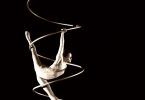Aerial arts demand strength, flexibility, and precision, but they pose unique physical challenges. Physiotherapy for aerial artists bridges the gap between artistry and optimal health, providing tools to prevent injuries, enhance performance, and ensure longevity in your practice. Whether you’re into aerial silks, hoops, or pole, physiotherapy can be a game-changer.
This article explores advanced physiotherapy methods that can enhance aerial performance, prevent injuries, and aid in recovery, ensuring a safer and more fulfilling aerial journey for performers of all levels.
The Role of Physiotherapy in Aerial Arts
Physiotherapy is crucial in enhancing an aerialist’s performance and overall well-being. You can significantly improve your strength, flexibility, and body awareness by incorporating physiotherapy techniques into your aerial training routine.
A skilled physiotherapist can help you address specific challenges related to aerial arts, such as building core strength, improving grip strength, and enhancing overall body control.
Benefits of Physiotherapy for Aerial Artists
Many aerial performers turn to physiotherapy for aerial artists to address imbalances and improve flexibility in their craft. Physiotherapy offers numerous benefits for aerial performers. It can help prevent injuries by identifying and addressing muscle imbalances, improving posture, and enhancing body mechanics.
Additionally, physiotherapy can aid in rehabilitation from existing injuries, allowing aerialists to return to their practice safely and efficiently.
By working with a healthcare professional specializing in physiotherapy for aerial arts, performers can develop personalized training programs that target their specific needs and goals. A tailored approach in physiotherapy for aerial artists helps develop body awareness and reduce injury risks.
How Often Should I Incorporate Physiotherapy Into My Training Routine?
The frequency of physiotherapy sessions depends on individual needs and goals. For most aerialists, incorporating physiotherapy techniques into their training routine 2-3 times per week can yield significant benefits. This may include a combination of hands-on treatment from a physiotherapist and exercises to be performed independently.
Regular physiotherapy sessions can help maintain optimal physical condition, reduce the risk of developing injuries, and enhance overall performance in aerial arts.
Can Physiotherapy Help Me Overcome Aerial-Specific Challenges?
Absolutely. Physiotherapy can address many aerial-specific challenges, such as improving shoulder stability for intricate silk wraps, enhancing hip flexibility for advanced pole moves, or increasing grip strength for prolonged hangs on the aerial hoop.
A physiotherapist with experience in aerial arts can develop targeted exercises and techniques to help you overcome these challenges and progress in your aerial journey.
What Are The Best Conditioning Exercises For Aerial Fitness?
Conditioning exercises are essential for building the strength and endurance required for aerial arts. A well-rounded conditioning program should focus on developing core strength, upper body power, and overall body control.
Conditioning exercises recommended by physiotherapy for aerial artists focus on building core and grip strength essential for aerial moves. Incorporating exercises that mimic aerial movements can help prepare the body for the unique demands of aerial performance.
How Can I Build A Strong Foundation For Aerial Skills?
Building a strong foundation for aerial skills involves developing core strength, upper body strength, and grip strength. Exercises such as planks, push-ups, pull-ups, and hanging leg raises can help create a solid base for aerial performance.
Additionally, incorporating exercises that target the rotator cuff muscles and scapular stabilizers can improve shoulder stability, which is crucial for many aerial movements.
How Physiotherapy Addresses Aerial-Specific Challenges
Aerial arts require strength in various muscle groups, particularly the core, upper body, and grip muscles. Exercises that target these areas include:
- TRX or suspension training exercises for core and upper body strength
- Deadlifts and farmer’s walks for grip strength
- Pike compressions and straddle lifts for abdominal strength and hip flexor engagement
- Shoulder presses and lat pull-downs for upper body strength 5. Russian twists and oblique crunches for rotational core strength
Key benefits of physiotherapy for aerial artists include enhanced joint stability and tailored training regimens.
Key Physiotherapy Techniques for Aerialists
Balancing strength and flexibility training is crucial for optimal aerial performance. While strength is necessary for executing aerial moves, flexibility allows for graceful and fluid movements.
A well-designed training program should include both strength and flexibility exercises, with a focus on active flexibility. This involves not only stretching but also strengthening muscles through their full range of motion. Incorporating techniques such as PNF (proprioceptive neuromuscular facilitation) stretching can help improve both strength and flexibility simultaneously.
How Can I Enhance My Range Of Motion For Aerial Silks And Pole Fitness?
Enhancing range of motion is essential for advancing in aerial silks and pole fitness. Improved flexibility allows for more impressive and intricate moves, as well as reducing the risk of injury.
A combination of stretching techniques, mobility exercises, and targeted strength training can help increase your range of motion safely and effectively.
How Can I Safely Increase Flexibility For Advanced Aerial Moves?
Safely increasing flexibility for advanced aerial moves requires a gradual and consistent approach. Start by identifying the specific areas that need improvement for your desired moves. Then, develop a stretching routine that targets these areas, focusing on both active and passive flexibility.
It’s crucial to listen to your body and avoid overstretching, which can lead to injury. Working with a physiotherapist or flexibility coach can help ensure you’re using safe and effective techniques to increase your range of motion.
Are There Specific Physiotherapy Methods To Improve Aerial-Related Flexibility?
Yes, several physiotherapy methods can improve aerial-related flexibility:
- Manual therapy techniques to release tight fascia and improve joint mobility
- Neuromuscular re-education to improve muscle activation and control throughout the range of motion
- Muscle energy techniques to lengthen tight muscles and improve joint flexibility
- Cupping therapy to increase blood flow and tissue mobility
- Kinesio taping to provide support and feedback during stretching exercises
What Injury Prevention Strategies Should Aerialists Incorporate Into Their Training?
Injury prevention is crucial for maintaining a long and successful aerial career. Incorporating proper warm-up and cool-down routines, focusing on correct technique, and listening to your body are all essential components of injury prevention.
Additionally, regular physiotherapy check-ups can help identify and address potential issues before they become serious injuries.
How Can I Identify And Address Potential Weak Points In My Aerial Practice?
Identifying weak points in your aerial practice involves regular self-assessment and feedback from instructors or physiotherapists. Pay attention to any persistent discomfort or difficulty with specific moves.
A physiotherapist can perform a comprehensive assessment to identify muscle imbalances, joint restrictions, or movement patterns that may lead to injury. Once identified, these weak points can be addressed through targeted exercises, manual therapy, and technique modifications.
What Are The Most Common Injuries In Aerial Arts And How Can Physiotherapy Help Prevent Them?
Common injuries in aerial arts include shoulder impingement, wrist strains, lower back pain, and rotator cuff injuries. Physiotherapy can help prevent these injuries by:
- Improving shoulder stability and scapular control
- Strengthening the muscles supporting the wrists and forearms
- Enhancing core strength and spinal stability
- Addressing muscle imbalances that may lead to overuse injuries
- Providing education on proper body mechanics and technique
How Important Is Proper Warm-Up And Cool-Down For Injury Prevention In Aerial Fitness?
Proper warm-up and cool-down routines are crucial for injury prevention in aerial fitness. A thorough warm-up helps prepare the body for the demands of aerial training by increasing blood flow, raising body temperature, and improving muscle elasticity. This can significantly reduce the risk of strains and sprains.
A proper cool-down, including gentle stretching and self-massage, helps prevent muscle soreness and promotes recovery. Incorporating both into your training routine is essential for maintaining long-term health and performance in aerial arts.
How Can Respiratory Physiotherapy Techniques Benefit Aerial Performers?
Respiratory physiotherapy techniques can greatly benefit aerial performers by improving lung function, enhancing endurance, and optimizing oxygen delivery to muscles during performance.
These techniques, originally developed for ICU patients and individuals with respiratory dysfunction, have been adapted to benefit athletes and performers in various disciplines, including aerial arts.
What Breathing Exercises Can Improve Endurance During Aerial Routines?
Several breathing exercises can improve endurance during aerial routines:
- Diaphragmatic breathing to increase lung volume and efficiency
- Pursed-lip breathing to improve oxygen exchange and reduce breathlessness
- Box breathing to enhance breath control and reduce anxiety during challenging moves
- Inspiratory muscle training to strengthen the muscles involved in inhalation
- Positive expiratory pressure techniques to improve overall lung function
How Does The Respiratory System Affect Aerial Performance?
The respiratory system plays a crucial role in aerial performance. Efficient breathing helps maintain proper oxygenation of muscles, reducing fatigue and improving endurance. It also aids in maintaining core stability and body control during complex aerial moves.
Additionally, controlled breathing can help manage performance anxiety and promote a sense of calm and focus during routines. By optimizing respiratory function, aerialists can enhance their overall performance and execute more challenging sequences with greater ease.
Can Positive Expiratory Pressure Techniques Enhance Aerial Stamina?
Positive expiratory pressure (PEP) techniques, originally developed for patients with respiratory dysfunction, can indeed enhance aerial stamina. These techniques involve breathing against resistance during exhalation, which can help improve lung volume, clear airways, and strengthen respiratory muscles.
For aerialists, incorporating PEP techniques into their training routine can lead to improved breath control, increased lung capacity, and enhanced overall endurance during aerial performances.
What Recovery Methods Should Aerialists Use To Optimize Performance And Prevent Burnout?
Effective recovery is essential for optimizing performance and preventing burnout in aerial arts. A comprehensive recovery plan should include both active and passive recovery methods, proper nutrition, and adequate rest.
Incorporating physiotherapy techniques into your recovery routine can help address muscle soreness, improve tissue healing, and maintain overall physical well-being.
How Can I Incorporate Active Recovery Into My Aerial Training Schedule?
Active recovery involves low-intensity exercises that promote blood flow and aid in muscle recovery without causing additional stress to the body. For aerialists, this may include:
- Gentle yoga or stretching sessions
- Low-intensity cardio, such as swimming or cycling
- Foam rolling or self-massage techniques
- Light bodyweight exercises focusing on mobility and stability
- Mindfulness practices, such as meditation or breathing exercises
What Role Does Nutrition Play In Recovery For Aerial Athletes?
Nutrition plays a crucial role in the recovery of aerial athletes. Proper nutrition supports muscle repair, replenishes energy stores, and helps maintain overall health. Key nutritional considerations for aerialists include:
- Adequate protein intake to support muscle repair and growth
- Complex carbohydrates to replenish glycogen stores
- Healthy fats support hormone production and reduce inflammation
- Hydration to maintain fluid balance and support muscle function
- Antioxidant-rich foods to combat oxidative stress from intense training
Post-Performance Recovery with Physiotherapy
Yes, several physiotherapy techniques can aid in post-performance recovery for aerialists:
- Manual therapy techniques, such as massage and myofascial release, to alleviate muscle tension and promote relaxation
- Cryotherapy or ice baths to reduce inflammation and muscle soreness
- Compression garments to improve circulation and reduce swelling
- Electrical stimulation to promote muscle recovery and reduce pain
- Gentle joint mobilizations to maintain proper range of motion and prevent stiffness
In conclusion, incorporating advanced physiotherapy techniques into your aerial training and recovery routine can significantly enhance your performance, prevent injuries, and promote long-term health in your aerial journey. By working with healthcare professionals experienced in aerial arts and implementing these strategies, you can push your boundaries safely and achieve new heights in your aerial practice.







